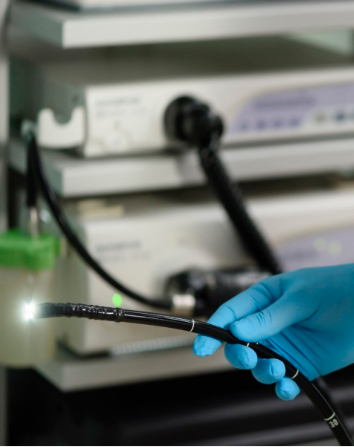
Endoscopy Unit
Our endoscopy unit looks for signs and symptoms to detect gastrointestinal diseases and disorders and solve them through treatment, using the latest endoscopic equipment designs and methods.
Endoscopy is a medical procedure that uses a tiny camera the size of a large vitamin pill. The endoscope capsule has a light to illuminate your digestive system, a camera to take images, and an antenna to send those images to a recorder worn on a belt. The images are high resolution for accurate diagnoses, since the organs can be observed directly and detect digestive tract injuries, tumors, malformations, polyps, hemorrhages, esophageal reflux, suspected gastric or duodenal ulcer, malabsorption problems or poor digestion of food, celiac disease, etc.
There are different types of endoscopies depending on their purpose:
- Gastroscopy. It is used for the study of the upper digestive tract; esophagus, stomach, and small intestine (duodenum).
- Colonoscopy. Used to examine the colon (large intestine) and rectum internally.
- Therapeutic endoscopy. Also, the use of special instruments can solve digestive system problems such as removing polyps, removing foreign objects, or cauterizing ulcers.
We have the diagnosis and treatment of the following conditions in our endoscopy unit:
Peptic ulcer bleeding
They occur when acid from the digestive system wears down the inner lining of the stomach (gastric ulcers) and the upper part of the small intestine (duodenal ulcers). Peptic ulcers can cause serious symptoms like vomiting blood or dark (black) bleeding in the stool. In patients with high-risk ulcers, endoscopic therapy is effective in cauterizing ulcers.
Gallstones
They are hardened deposits that can form in the gallbladder from the solidification of digestive fluid (bile). Bile is a fluid produced by the liver that is released into the small intestine through the bile ducts, helping to digest fats. In some cases, gallstones can block the duct causing severe pain in the abdomen.
Colon cancer
Colon cancer (large intestine) regularly begins with a set of benign cells called polyps that over time can turn into cancer, so it is important that you have regular preventive check-ups for the detection of benign polyps or colon cancer in early stage for a greater chance of cure.
Esophageal varices
They are generally formed due to liver disease, these develop when the normal flow of blood to the liver is blocked by a clot or fibrous tissue, as this duct is blocked, the blood circulates through smaller blood vessels that are not designed for large ones. volumes of blood and these can rupture causing bleeding.
Hereditary adenomatous polyposis
It is a hereditary congenital disease in which polyps form in the large intestine (colon) and rectum or in the upper part of the small intestine (duodenum), these polyps can manifest colorectal cancer or other complications if they are not treated.
Gastroesophageal reflux disease.
Chronic digestive disease in which acid or bile irritates the lining of the esophagus. When acid reflux and heartburn happen more than twice a week, it can be an indication of gastroesophageal reflux.
Pancreatic pseudocysts
They are accumulations of fluid that form within a cavity or space within the pancreas without being contained in a closed structure. Treatment depends on the type of cyst you have.
Stenosis of the bile ducts
This is when the duct that carries bile narrows abnormally. A multidisciplinary team is required to evaluate the general conditions of each case.
Where to Find Us

Campus Observatorio
Sur 136 No. 116, Col. Las Américas, Álvaro Obregón, 01120, Cd. de México.

Campus Santa Fe
Av. Carlos Graef Fernández 154, Col. Santa Fe, Cuajimalpa, 05300, Cd. de México.


